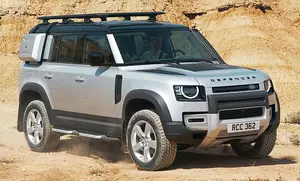


| Engine | 0—60 mph | 0—100 km/h | Top Speed | Averange Economy |
|---|---|---|---|---|
| 2.0 SD4 | 8.6 s | 9.1 s | 117 mph | - |
| 3.0 I6 | 5.8 s | 6.1 s | 119 mph | - |
| 2.0 Si4 | 7.7 s | 8.1 s | 119 mph | - |
| Engine | 2.0 SD4 |
|---|---|
| 0—60 mph | 8.6 s |
| 0—100 km/h | 9.1 s |
| Top Speed | 117 mph |
| Averange Economy | - |
| Engine | 3.0 I6 |
| 0—60 mph | 5.8 s |
| 0—100 km/h | 6.1 s |
| Top Speed | 119 mph |
| Averange Economy | - |
| Engine | 2.0 Si4 |
| 0—60 mph | 7.7 s |
| 0—100 km/h | 8.1 s |
| Top Speed | 119 mph |
| Averange Economy | - |
In 2020, Land Rover Defender 0-60 acceleration was between 5.8 and 8.6 seconds.
Land Rover Defender 0-60 mph was up to 39% faster in 2020 than world's average.
In 2020, Land Rover Defender 0-60 mph to car weight ratio is shown below:
| Vehicle | Acceleration 0—60 mph (0—100 km/h) | Maximum speed | Acceleration to passenger ratio | Fuel consumption at high speed | Fuel type / gearbox |
|---|---|---|---|---|---|
| 2.0 SD4 | 8.6 s to 60 mph (9.1 s to 100 km/h) | 117 mph (188 km/h) | 1.7 s to 60 mph / person | - | Diesel / 8 |
| 3.0 I6 | 5.8 s to 60 mph (6.1 s to 100 km/h) | 119 mph (191 km/h) | 1.2 s to 60 mph / person | - | Petrol (Gasoline) / 8 |
| 2.0 Si4 | 7.7 s to 60 mph (8.1 s to 100 km/h) | 119 mph (191 km/h) | 1.5 s to 60 mph / person | - | Petrol (Gasoline) / 8 |
| Vehicle | 2.0 SD4 |
|---|---|
| Acceleration 0-60 mph (0-100 km/h) | 8.6 s to 60 mph (9.1 s to 100 km/h) |
| Maximum speed | 117 mph (188 km/h) |
| Acceleration to passenger ratio | 1.7 s to 60 mph / person |
| Fuel consumption at high speed | - |
| Fuel type / gearbox | Diesel / 8 |
| Vehicle | 3.0 I6 |
| Acceleration 0-60 mph (0-100 km/h) | 5.8 s to 60 mph (6.1 s to 100 km/h) |
| Maximum speed | 119 mph (191 km/h) |
| Acceleration to passenger ratio | 1.2 s to 60 mph / person |
| Fuel consumption at high speed | - |
| Fuel type / gearbox | Petrol (Gasoline) / 8 |
| Vehicle | 2.0 Si4 |
| Acceleration 0-60 mph (0-100 km/h) | 7.7 s to 60 mph (8.1 s to 100 km/h) |
| Maximum speed | 119 mph (191 km/h) |
| Acceleration to passenger ratio | 1.5 s to 60 mph / person |
| Fuel consumption at high speed | - |
| Fuel type / gearbox | Petrol (Gasoline) / 8 |

| Engine | 0—60 mph | 0—100 km/h | Top Speed | Averange Economy |
|---|---|---|---|---|
| 2.0 SD4 | 9.7 s | 10.2 s | 109 mph | - |
| 2.0 Si4 | 7.6 s | 8 s | 119 mph | - |
| 3.0 I6 | 5.7 s | 6 s | 119 mph | - |
| Engine | 2.0 SD4 |
|---|---|
| 0—60 mph | 9.7 s |
| 0—100 km/h | 10.2 s |
| Top Speed | 109 mph |
| Averange Economy | - |
| Engine | 2.0 Si4 |
| 0—60 mph | 7.6 s |
| 0—100 km/h | 8 s |
| Top Speed | 119 mph |
| Averange Economy | - |
| Engine | 3.0 I6 |
| 0—60 mph | 5.7 s |
| 0—100 km/h | 6 s |
| Top Speed | 119 mph |
| Averange Economy | - |
In 2020, Land Rover Defender 0-60 acceleration was between 5.7 and 9.7 seconds.
Land Rover Defender 0-60 mph was up to 2% slower in 2020 than world's average.
In 2020, Land Rover Defender 0-60 mph to car weight ratio is shown below:
| Vehicle | Acceleration 0—60 mph (0—100 km/h) | Maximum speed | Acceleration to passenger ratio | Fuel consumption at high speed | Fuel type / gearbox |
|---|---|---|---|---|---|
| 2.0 SD4 | 9.7 s to 60 mph (10.2 s to 100 km/h) | 109 mph (175 km/h) | 1.9 s to 60 mph / person | - | Diesel / 8 |
| 2.0 Si4 | 7.6 s to 60 mph (8 s to 100 km/h) | 119 mph (191 km/h) | 1.5 s to 60 mph / person | - | Petrol (Gasoline) / 8 |
| 3.0 I6 | 5.7 s to 60 mph (6 s to 100 km/h) | 119 mph (191 km/h) | 1.1 s to 60 mph / person | - | Petrol (Gasoline) / 8 |
| Vehicle | 2.0 SD4 |
|---|---|
| Acceleration 0-60 mph (0-100 km/h) | 9.7 s to 60 mph (10.2 s to 100 km/h) |
| Maximum speed | 109 mph (175 km/h) |
| Acceleration to passenger ratio | 1.9 s to 60 mph / person |
| Fuel consumption at high speed | - |
| Fuel type / gearbox | Diesel / 8 |
| Vehicle | 2.0 Si4 |
| Acceleration 0-60 mph (0-100 km/h) | 7.6 s to 60 mph (8 s to 100 km/h) |
| Maximum speed | 119 mph (191 km/h) |
| Acceleration to passenger ratio | 1.5 s to 60 mph / person |
| Fuel consumption at high speed | - |
| Fuel type / gearbox | Petrol (Gasoline) / 8 |
| Vehicle | 3.0 I6 |
| Acceleration 0-60 mph (0-100 km/h) | 5.7 s to 60 mph (6 s to 100 km/h) |
| Maximum speed | 119 mph (191 km/h) |
| Acceleration to passenger ratio | 1.1 s to 60 mph / person |
| Fuel consumption at high speed | - |
| Fuel type / gearbox | Petrol (Gasoline) / 8 |

| Engine | 0—60 mph | 0—100 km/h | Top Speed | Averange Economy |
|---|---|---|---|---|
| 5.0 V8 | 5.5 s | 5.8 s | 106 mph | - |
| Engine | 5.0 V8 |
|---|---|
| 0—60 mph | 5.5 s |
| 0—100 km/h | 5.8 s |
| Top Speed | 106 mph |
| Averange Economy | - |
In 2018 Land Rover Defender 0-60 acceleration was 5.5 seconds.
Land Rover Defender 0-60 mph was up to 42% faster in 2018 than world's average.
| Vehicle | Acceleration 0—60 mph (0—100 km/h) | Maximum speed | Acceleration to passenger ratio | Fuel consumption at high speed | Fuel type / gearbox |
|---|---|---|---|---|---|
| 5.0 V8 | 5.5 s to 60 mph (5.8 s to 100 km/h) | 106 mph (171 km/h) | 2.8 s to 60 mph / person | - | Petrol (Gasoline) / 8 |
| Vehicle | 5.0 V8 |
|---|---|
| Acceleration 0-60 mph (0-100 km/h) | 5.5 s to 60 mph (5.8 s to 100 km/h) |
| Maximum speed | 106 mph (171 km/h) |
| Acceleration to passenger ratio | 2.8 s to 60 mph / person |
| Fuel consumption at high speed | - |
| Fuel type / gearbox | Petrol (Gasoline) / 8 |

| Engine | 0—60 mph | 0—100 km/h | Top Speed | Averange Economy |
|---|---|---|---|---|
| 2.5 TD5 | 18.5 s | 19.5 s | 80 mph | 22 mpg |
| Engine | 2.5 TD5 |
|---|---|
| 0—60 mph | 18.5 s |
| 0—100 km/h | 19.5 s |
| Top Speed | 80 mph |
| Averange Economy | 22 mpg |
In 1995 Land Rover Defender 0-60 acceleration was 18.5 seconds.
Land Rover Defender 0-60 mph was up to 94% slower in 1995 than world's average.
In 1995, Land Rover Defender 0-60 mph to car weight ratio is shown below:
| Vehicle | Acceleration 0—60 mph (0—100 km/h) | Maximum speed | Acceleration to passenger ratio | Fuel consumption at high speed | Fuel type / gearbox |
|---|---|---|---|---|---|
| 2.5 TD5 | 18.5 s to 60 mph (19.5 s to 100 km/h) | 80 mph (129 km/h) | 3.7 s to 60 mph / person | - | Diesel |
| Vehicle | 2.5 TD5 |
|---|---|
| Acceleration 0-60 mph (0-100 km/h) | 18.5 s to 60 mph (19.5 s to 100 km/h) |
| Maximum speed | 80 mph (129 km/h) |
| Acceleration to passenger ratio | 3.7 s to 60 mph / person |
| Fuel consumption at high speed | - |
| Fuel type / gearbox | Diesel |

| Engine | 0—60 mph | 0—100 km/h | Top Speed | Averange Economy |
|---|---|---|---|---|
| 2.5 TD5 | 17.9 s | 18.8 s | 81 mph | 21 mpg |
| 2.5 TDi | 17.2 s | 18.1 s | 80 mph | 22 mpg |
| Engine | 2.5 TD5 |
|---|---|
| 0—60 mph | 17.9 s |
| 0—100 km/h | 18.8 s |
| Top Speed | 81 mph |
| Averange Economy | 21 mpg |
| Engine | 2.5 TDi |
| 0—60 mph | 17.2 s |
| 0—100 km/h | 18.1 s |
| Top Speed | 80 mph |
| Averange Economy | 22 mpg |
In 1983, Land Rover Defender 0-60 acceleration was between 17.2 and 17.9 seconds.
Land Rover Defender 0-60 mph was up to 88% slower in 1983 than world's average.
In 1983, Land Rover Defender 0-60 mph to car weight ratio is shown below:
| Vehicle | Acceleration 0—60 mph (0—100 km/h) | Maximum speed | Acceleration to passenger ratio | Fuel consumption at high speed | Fuel type / gearbox |
|---|---|---|---|---|---|
| 2.5 TD5 | 17.9 s to 60 mph (18.8 s to 100 km/h) | 81 mph (130 km/h) | 3.6 s to 60 mph / person | 22 mpg (10.8 L per 100 km) | Diesel |
| 2.5 TDi | 17.2 s to 60 mph (18.1 s to 100 km/h) | 80 mph (129 km/h) | 3.4 s to 60 mph / person | - | Diesel |
| Vehicle | 2.5 TD5 |
|---|---|
| Acceleration 0-60 mph (0-100 km/h) | 17.9 s to 60 mph (18.8 s to 100 km/h) |
| Maximum speed | 81 mph (130 km/h) |
| Acceleration to passenger ratio | 3.6 s to 60 mph / person |
| Fuel consumption at high speed | 22 mpg (10.8 L per 100 km) |
| Fuel type / gearbox | Diesel |
| Vehicle | 2.5 TDi |
| Acceleration 0-60 mph (0-100 km/h) | 17.2 s to 60 mph (18.1 s to 100 km/h) |
| Maximum speed | 80 mph (129 km/h) |
| Acceleration to passenger ratio | 3.4 s to 60 mph / person |
| Fuel consumption at high speed | - |
| Fuel type / gearbox | Diesel |

| Engine | 0—60 mph | 0—100 km/h | Top Speed | Averange Economy |
|---|---|---|---|---|
| 2.5 TD5 | 16.6 s | 17.5 s | 81 mph | 23 mpg |
| 2.5 TDi | 17.2 s | 18.1 s | 80 mph | 22 mpg |
| Engine | 2.5 TD5 |
|---|---|
| 0—60 mph | 16.6 s |
| 0—100 km/h | 17.5 s |
| Top Speed | 81 mph |
| Averange Economy | 23 mpg |
| Engine | 2.5 TDi |
| 0—60 mph | 17.2 s |
| 0—100 km/h | 18.1 s |
| Top Speed | 80 mph |
| Averange Economy | 22 mpg |
In 1983, Land Rover Defender 0-60 acceleration was between 16.6 and 17.2 seconds.
Land Rover Defender 0-60 mph was up to 81% slower in 1983 than world's average.
In 1983, Land Rover Defender 0-60 mph to car weight ratio is shown below:
| Vehicle | Acceleration 0—60 mph (0—100 km/h) | Maximum speed | Acceleration to passenger ratio | Fuel consumption at high speed | Fuel type / gearbox |
|---|---|---|---|---|---|
| 2.5 TD5 | 16.6 s to 60 mph (17.5 s to 100 km/h) | 81 mph (130 km/h) | 2.8 s to 60 mph / person | 27 mpg (8.8 L per 100 km) | Diesel |
| 2.5 TDi | 17.2 s to 60 mph (18.1 s to 100 km/h) | 80 mph (129 km/h) | 2.9 s to 60 mph / person | - | Diesel |
| Vehicle | 2.5 TD5 |
|---|---|
| Acceleration 0-60 mph (0-100 km/h) | 16.6 s to 60 mph (17.5 s to 100 km/h) |
| Maximum speed | 81 mph (130 km/h) |
| Acceleration to passenger ratio | 2.8 s to 60 mph / person |
| Fuel consumption at high speed | 27 mpg (8.8 L per 100 km) |
| Fuel type / gearbox | Diesel |
| Vehicle | 2.5 TDi |
| Acceleration 0-60 mph (0-100 km/h) | 17.2 s to 60 mph (18.1 s to 100 km/h) |
| Maximum speed | 80 mph (129 km/h) |
| Acceleration to passenger ratio | 2.9 s to 60 mph / person |
| Fuel consumption at high speed | - |
| Fuel type / gearbox | Diesel |